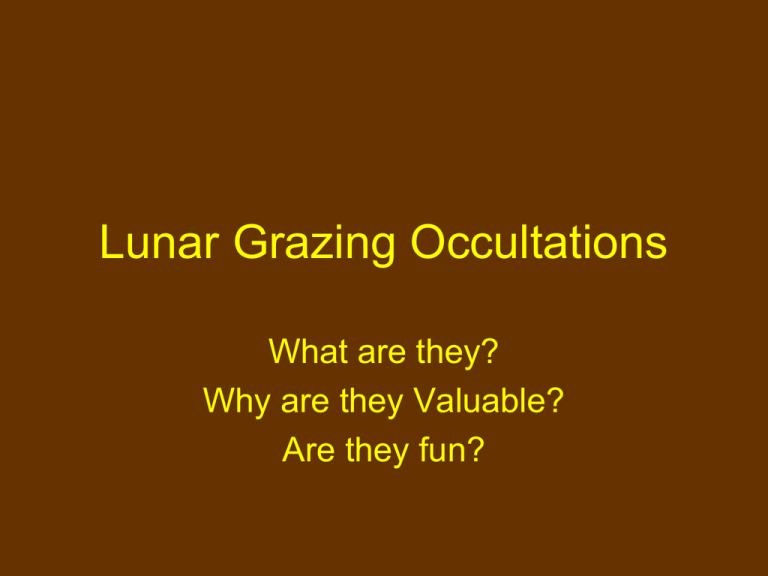Lunar Grazing Occultations What are they? Why are they Valuable? Are they fun?
advertisement

Lunar Grazing Occultations What are they? Why are they Valuable? Are they fun? What is a Lunar Occultation? • An “occultation” happens when one celestial object moves in front of a much smaller more distant celestial object • (If the objects are comparable in size, it’s usually called an “eclipse” instead) • As the moon moves through it’s orbit, it passes in front of distant stars or planets. This essentially casts a shadow on the Earth and from within this shadow, you can watch the star approach the moon and wink off when it disappears, and / or wink on when it reappears • Here are some bright star lunar occultation shadow paths in 2014 visible from Santa Cruz… Some Very Cool Occultation/Graze Videos • A waning crescent moon graze of the 1st magnitude star Spica (YouTube 4min 21sec) • Waxing cresent graze of 2 Scorpii. 22 events, clear double star with step events. (Dave Gault) (YouTube 4:40). Note Kiwi time and frame stamping. • A double graze expedition in Australia adventure (YouTube 8min) • Graze of Aldebaren on waxing crescent moon with excited commentary (1:07) • An occultation of the planet Uranus. Note the slow brightening, since Uranus is 4 arcsec across, not a point source of light like a star Why are Grazes Valuable? • #1. Keeping track of the Earth’s slightly varying rotation rate. The exact timings of D’s and R’s depends on your position in space, which depends on how the Earth is rotating. It changes gradually due to… • --- tidal friction with the moon, • --- tidal friction with the sun, • --- massive Earthquakes can change the rotational moment of inertia of the Earth and change our rotation rate in a slight but discontinuous way. • --- --- Precisely determining the changing relative coordinate systems fixed to the solar system, the coordinate system fixed to the stars and galaxies beyond • --- Using video records, measure the precise brightnesses of known close double stars, discovery of new close binary stars #2: Quantifying subtle differences between Newtonian gravity and General Relativity • Warped space in General Relativity causes additional precession in the lunar orbit • “Frame Dragging” also changes the moon’s orbit slightly #3. Mapping the edge regions of the moon. • The Watts charts created in the 1940’s and 1950’s used ground telescopes, but recently the Kaguya spacecraft (JAXA Japan) orbited the moon and precisely photographed and mapped the lunar edge region. • Now, timings can be related to the exact topography of the moon with little uncertainty. #4: Precisely Measuring the Diameter of the Sun • Timing the appearance/disappearences of Bailey’s Beads at solar eclipses • If photometry can be precisely calibrated (too difficult so far), then we can use the moon as a fixed yardstick by which to measure the possible changes in the diameter of the sun by measuring “Bailey’s Beads” timings during solar eclipses • YouTube 6min video of annular Bailey’s Beads Jan 10, 2010 annular eclipse in India • YouTube 3 min video of May 10 ’94 Baileys Beads at annular eclipse The Problem Here is… • The photosphere is fuzzy, like the edge of a cloud. It’s about 350 km in thickness. Since the moon is 400 times closer, that corresponds to about 1 km thickness on the moon, and this is very wide; about the height of typical lunar mountains. • It means without highly precise photometry, we won’t be able to tell the diameter of the sun using Bailey’s Beads to any better than about 50-100 km at best, and this isn’t very precise. To this precision, the sun is not changing its size Bailey’s Beads at 1999 Solar Eclipse Bailey’s Beads at Annular Eclipse 2010 An Example: Two Grazes in Carrizo Plain National Monument in 2014 • The first graze is of 6.0 magnitude ZC 718, a K5 red giant in Gemini, at 8:10pm PDT. • The path nicely goes across the southern edge of Soda Lake, and we'll want to set up stations along the road to the Visitor's Center, with a particularly favorable station being right at the gate to Painted Rock (which will be locked) at the Visitor's Center. The star is red and so will be brighter than magnitude 6.0 on the video (which is red-sensitive). Our Graze Stars, and Nearby Open Star Cluster The ZC 718 Graze Path, crosses also near Tucson AZ and Houston, TX where there are active occultation astronomers who may also get data Site for ZC 718 Graze Line (blue): Near Goodwin Visitor’s Center Northern Limit, Dark Side; Profile for First Graze 2nd Graze only 90 min later, so we’ll have to hustle a ~10 miles further north to get to it. No dawdling! • Pack up your station quickly and follow me to our second graze site north of Soda Lake. • We’ll observe it, and only then have a debriefing about what happened for both grazes. • ZC 726, 10 degrees from northern cusp of the 40% crescent moon, magnitude 7.0 so only about half as bright as the first graze star. This northern limit path also crosses very close to Tucson and may be observed from there. ZC 726 Graze: On Pole Line Road at 9:35pm Orange “x” marks primary site along “7 Mile Rd”. Green is sealevel graze limit. Drive up Soda Lake Rd, turn right at “7 Mile Rd” and go a ~couple of miles Profile is very flat; could be spectacular number of D’s and R’s How To Record D’s and R’s • We’ll have ~3 graze stations. Mine, using video recording. A “student station”, and then “TA’s Station”, all just a few hundred yards apart. • Student station and TA station will use tape recorders and SW radios and shout “D!” and “R!” at each event, recording WWV at 5 Mhz along with the timings. • Lab Assistant Dave McKulle has a way of turning the audio recording into a visual trace so it’ll be much easier to extract timings for our student graze site, but only if students chatter is quiet during the graze period! • OK – “good luck, Jim!” (from “Mission: Impossible”




